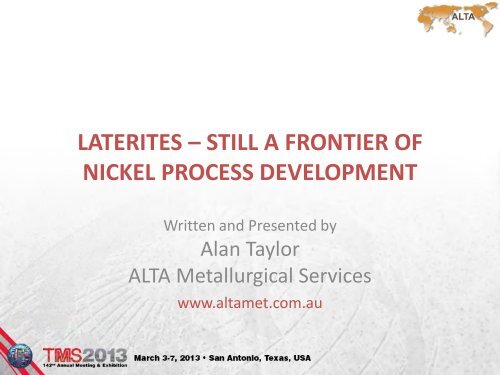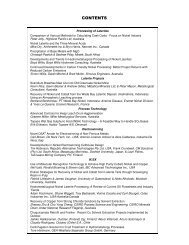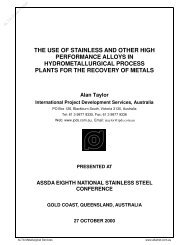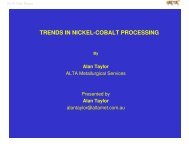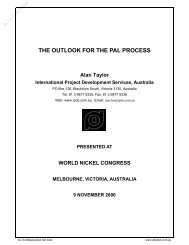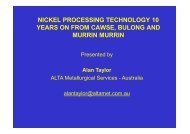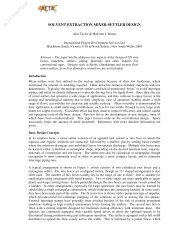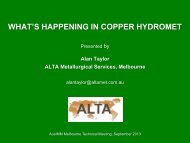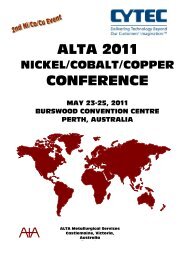laterites - ALTA Metallurgical Services
laterites - ALTA Metallurgical Services
laterites - ALTA Metallurgical Services
Create successful ePaper yourself
Turn your PDF publications into a flip-book with our unique Google optimized e-Paper software.
LATERITES – STILL A FRONTIER OFNICKEL PROCESS DEVELOPMENTWritten and Presented byAlan Taylor<strong>ALTA</strong> <strong>Metallurgical</strong> <strong>Services</strong>www.altamet.com.au
INTRODUCTION (cont.)• Note: There is a also single known application of ferronickelsmelting operated by LARCO, Greece.• However, ferronickel smelting is generally considered to beuneconomic for low grade <strong>laterites</strong>.3
CARON PROCESS• It is not a new process and was first proposed by ProfessorCaron, Delft University Netherlands, in the 1920s.• It was pioneered commercially by Freeport at Nicaro, Cuba, in1944, then taken over by the Cuban Government in 1960. It isstill in operation.• A further five plants were constructed in the 1970s-1990s,one of which was closed (Nonoc in the Philippines) and onenever completed (Los Camariocas in Cuba).4
TYPICAL CARON FLOWSHEET5
CURRENT CARON INSTALLATIONSPlant Start-up Date Builder LocationNicaro 1944 Freeport CubaYabulu 1974 Freeport Qld, AustraliaTocantins 1982 Votorantim BrazilPunta Gorda 1986 Cuban-Russian Cuba6
YABULU OPERATION, AUSTRALIA7
ISSUES WITH CARON FLOWSHEET• It has high energy consumption for the initial ore drying step.• Nickel recovery is only moderately high.• Cobalt recovery is relatively low.• It is generally limited to limonite and mixed ores with >35%Fe.• Recovery falls off with saprolite ores.• It is sensitive to mineral composition and requires carefulmining and blending.8
PAL PROCESS• The process is also not new. The first plant was commissionedby Freeport at Moa Nay, Cuba, in 1959. It was also taken overby the Cuban Government in 1960 and remains in operationtoday.• The next major action was not until the development of theAMAX and Nical Processes in the 1970s and 1980s for theProny Project in New Caledonia and the Gasquet Project inNorthern California respectively. Neither reachedcommercialization due mainly to low nickel price.• In fact there were no further commercial PAL operations tillthe 1990s when three plants were built in Western Australia,namely Bulong, Cawse & Murrin Murrin (Bulong and Cawseare now closed).9
PAL PROCESS (cont.)• Since then, five PAL plants (not including the RavensthorpeEPAL plant) have been constructed and are either operating orin commissioning; a further two are under construction.• The main driving forces for the PAL projects include:– Increased nickel demand and higher price.– Availability of numerous low grade laterite deposits.– Higher energy efficiency and higher nickel and cobalt recoveries thanthe Caron Process.– Longevity of the Moa Bay operation.– Successful commercial application of horizontal autoclaves and relatedfacilities for pressure leaching of other ores such as gold and zinc.10
TYPICAL PAL FLOWSHEET11
CURRENT PAL INSTALLATIONS(Excluding Ravensthorpe EPAL Plant)Plant Country Nickel (t/y) StatusMoa Bay Cuba 33,000 OperatingMurrin Murrin Australia 40,000 OperatingCoral Bay Philippines 20,000 OperatingGoro New Caledonia 60,000 OperatingAmbatovy Madagascar 60,000 CommissioningRamu PNG 31,000 CommissioningTaganito Philippines 30,000 ConstructionGordes Turkey 10,000 Construction12
MURRIN MURRIN OPERATION, AUSTRALIA13
ISSUES WITH PAL PROCESS• The capital cost is high.• It has a high acid consumption for saprolitic ores with highmagnesium content.• The process conditions are highly corrosive.• The maintenance cost is relatively high.• Autoclave descaling and maintenance involves significant pantdowntime.• Sophisticated control/safety systems are needed.• Downstream processing is complex.• There has been a lengthy ramp-up time for the majority ofprojects.14
EPAL PROCESS• It was developed by BHP Billiton and installed atRavensthorpe, Western Australia. Commissioningcommenced in late 2007, and operation was suspended inearly 2009, attributed to a fall in nickel price.• It was acquired by First Quantum in December 2009 andrestarted after modifications, with commercial productionachieved in late 2011.• Limonite ore is treated by PAL and saprolite ore byatmospheric tank leaching.15
EPAL PROCESS FLOWSHEET(Ref: Ravensthorpe Presentation at <strong>ALTA</strong> 2005)16
ISSUES WITH EPAL PROCESS• It retains the disadvantages of PAL for the limonite ore portionof the flowsheet.• It is relatively complex, with two different leach processes.17
DEVELOPING PROCESSES USINGSULPHURIC ACID• Pressure acid leaching (PAL) combined with atmosphericpressure agitated tank leaching (AL).• Stand-alone atmospheric pressure agitated leaching tank (AL).• Heap leaching (HL)18
PAL COMBINED WITH AL• These combine PAL for limonite with AL for saprolite in aparallel circuit and/or use saprolite to neutralize the residualacid from PAL.• Objectives include:– treating the whole orebody– reducing the net acid consumption for saprolite– eliminating or reducing the limestone needed to neutralize residualacid from limonite PAL– reducing capital cost.• It has been piloted by a number of companies as far back asAMAX and Nical in the 1970s, but not yet commercializedwith the exception of EPAL.19
STANDALONE AL• Standalone AL has also been tested by a numberorganizations. A recent example is Eramet who have adoptedAL for the Weda Bay Project in Indonesia.• The advantage of standalone AL is the absence of a PAL circuitwhich should translate into capital cost savings, reduced downtime and lower maintenance costs.• However, this may be offset by increased sulphuric acidconsumption.• Higher acid consumptions lead to higher iron and otherimpurities to downstream processing.20
PROPOSED WEDA BAY FLOWSHEET(Ref: Eramet Paper at <strong>ALTA</strong> 2012)21
ISSUES WITH AL• It generally has a high acid consumption, especially forsaprolite ore, leading to higher operating cost which offsetsthe saving in capital cost versus PAL.• It produces high levels of iron and other impurities in theleach solution which makes downstream processing morechallenging.• It is generally less effective for leaching limonite ore andsulphur dioxide injection may be needed to achieve highcobalt extraction.• It typically operates close to 100C so that expensive materialsof construction are needed.22
HEAP LEACHING• Development work has been carried out by numerousorganizations since the 1990’s, but no standalone commercialoperation has yet been established.• A commercial satellite operation treating grinding circuit scatswas established in 2007 by Minara at Murrin Murrin inWestern Australia. Fresh ore treatment was also successfullydemonstrated, but is not currently practiced as it is said to bemore profitable to send ore through the existing PAL circuit.• A stand-alone HL demonstration plant was operated byEuropean Nickel at Caldag in Turkey, in 2004; but the projectwas held up by permitting issues. It was sold in 2011 and isnow owned by VTG Nikel of Turkey who are aiming forcommercial operation.23
CALDAG HL DEMONSTRATION PLANT(Ref: European Nickel Paper at <strong>ALTA</strong> 2006)24
CALDAG DEMONSTRATION PLANT HLFLOWSHEET(Ref: European Nickel Paper at <strong>ALTA</strong> 2006)25
ISSUES WITH HL• Laterites frequently have a high fines content andagglomeration with a polymer is typically required.• Heap stability is a problem, especially in high rainfall locations.High rainfall can also cause breakdown of agglomerates andcause dilution of the leach solution.• It generally has a high acid consumption, especially forsaprolite ore, leading to higher operating cost which offsetsthe saving in capital cost versus PAL.• It typically produces higher levels of iron and other impuritiesin the leach solution than PAL, which makes downstreamprocessing more difficult.26
ISSUES WITH HL (Cont.)• Heap leaching of limonite ore typically yields low recoveries.• Decommissioning can be challenging especially at highrainfall sites.• Environmental issues can be greater that for PAL or AL.27
ADVANTAGES OF SULPHURIC ACID BASEDLEACHING PROCESSES• Key advantages of sulphuric acid for leaching <strong>laterites</strong> include:• It is the best known and most widely applied leaching reagentin the mining and metallurgical industry.• it is widely available at moderate cost.• It is commonly produced in the same industry – e.g. smelters.• On-site production yields very useful energy.• Intermediate products can be produced which significantlyreduces cost and simplifies operation.28
ISSUES WITH SULPHURIC ACID BASEDPROCESSES• Downstream processing is typically complex and is a majorcomponent of overall capital cost, especially if separate nickeland cobalt products are produced at site.• The leach solution is generally dilute with regard to nickel andcobalt, which adversely affects capital and operating costs.• The acid not regenerated and recycled.29
DEVELOPING PROCESSES USING CHLORIDELEACHING SYSTEMS• Chloride leaching processes for <strong>laterites</strong> have been tested by anumber of organizations.• Recent examples include Neomet in Canada, Anglo Researchin South Africa, Nichromet in Canada, Process ResearchOrtech in Canada and SMS Siemag in Austria.• There are no commercial plants for <strong>laterites</strong> as yet; however,there are a number of long established commercialoperations refining nickel matte in chloride conditions.30
POTENTIAL ADVANTAGES OF CHLORIDELEACHING OF LATERITES• It is an agitated tank leach at atmospheric pressure.• It is applicable to both limonite and saprolite ores.• It has lower capital and operating costs than PAL.• Nickel and cobalt recoveries are high.• The lixiviant is regenerated and recycled.• Separation and recovery of nickel and cobalt products iscomparatively straightforward and commercially proven methodsare available.• Secondary neutralization to remove residual iron is not needed.• Solid/separation properties are superior to sulphuric acid processes.• There are opportunities to recover saleable by-products.31
NEOMET PROCESS FLOWSHEET(Ref: Neomet Paper at <strong>ALTA</strong> 2011)32
ISSUES WITH CHLORIDE SYSTEMS• Chloride solutions are highly corrosive, especially at hightemperatures.• The handling of HCl vapours involves personnel safety issues.• Depending on the overall water balance, there can beenvironmental problems due to the release of chloridecontaining solutions.33
DEVELOPING PROCESSES USING NITRICLEACHING SYSTEMS• Nitric leaching systems have attracted limited interest for<strong>laterites</strong>.• A recent example is the DNi Process being developed byDirect Nickel in Western Australia.• There are no commercial plants as yet, however nitric systemshave been used for other leaching and refining applications.34
POTENTIAL ADVANTAGES OF NITRICLEACHING OF LATERITES• It is an agitated tank leach at atmospheric pressure.• It is applicable to both limonite and saprolite ores.• Lower capital and operating costs than PAL.• Nickel and cobalt recoveries ate high.• The lixiviant is regenerated and recycled .• The is no secondary neutralization to remove residual iron.• Solid/liquid separation properties are superior to sulphuricacid processes.• There are opportunities to recover saleable by-products.35
DNi PROCESS FLOWSHEET(Ref: Direct Nickel Paper at <strong>ALTA</strong> 2011)36
ISSUES WITH NITRIC SYSTEMS• Nitric acid solutions are highly corrosive, especially at hightemperatures.• The handling of vapours involves personnel safety issues.• Depending on the overall water balance, there can beenvironmental problems due to the release of nitratecontaining solutions.37
SUMMARY OF PRESENT STATUS FORPROCESSING OF LOW GRADE LATERITES• PAL dominates for recent projects. No recent Caron plantshave been built.• AL is being pursued for a number of projects, but there are nostand-alone operations as yet.• HL is still being pursued, though Interest has waned, andthere are no stand-alone operations as yet.• A number of chloride leaching processes are being developed,but there are no operations as yet.• A nitric acid leaching system is being developed by DirectNickel, but there is no commercial plant as yet.38
THE IDEAL LATERITE PROCESS• High recoveries of nickel and cobalt.• Lower capex and opex than existing processes• No initial drying and low overall energy requirement.• Atmospheric pressure operation.• Low net reagent consumption.• Straight forward downstream processing.• Ability to provide separate nickel and cobalt products.• Potential for saleable by-products.• Suitable for large and small projects.• Low to moderate corrosivity.• Low short and long term environmental impact.39
The field is still wide openThere is no clear winner as yetLaterites are still a very much a frontierof nickel process development40
REFERENCES1. Nickel Laterite Processing Technologies – Where To Next?,Jim Kyle, <strong>ALTA</strong> 2010, Perth, Western Australia.2. Treatment of Nickel-Cobalt Laterites Short Course,Alan Taylor, <strong>ALTA</strong> 2011, Perth, Western Australia.3. Developments and Trends in Hydrometallurgical Processingof Nickel Laterites, Boyd Willis, <strong>ALTA</strong> 2012, Perth, WesternAustralia.4. Nickel Laterite and Three Mineral Acids, Mike Dry and BrynHarris, <strong>ALTA</strong> 2012, Perth, Western Australia.41


